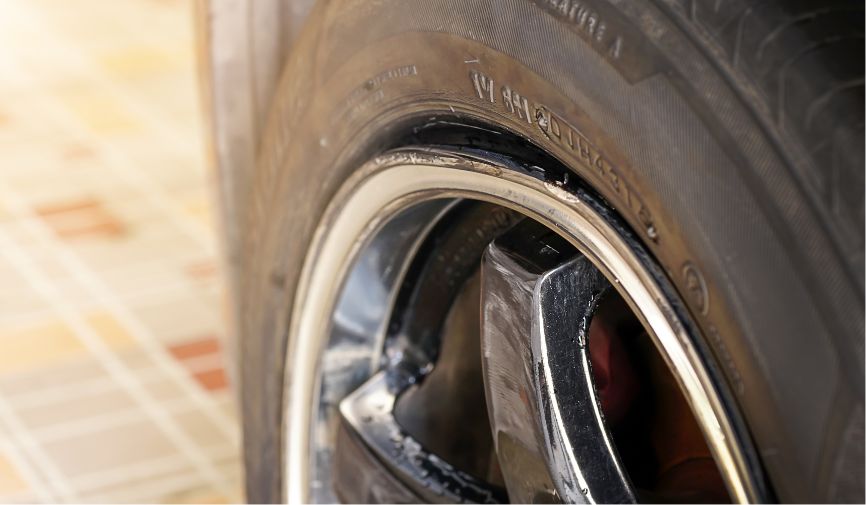Alloy wheels are a popular choice for many car owners due to their sleek appearance, durability, and performance benefits. However, like any other part of your vehicle, alloy wheels can sustain damage, particularly in the form of buckling, if they experience significant impact from potholes, curbs, or other road hazards. A buckled alloy wheel can lead to several driving issues, and if left unchecked, it can compromise your vehicle’s safety. Here, we’ll walk you through how to identify if your alloy wheel is buckled and what steps you can take to fix it.
How to Tell If Your Alloy Wheel Is Buckled
Identifying a buckled alloy wheel isn’t always straightforward, as the damage may not be visible at first glance. However, here are some signs to watch out for:
1. Vibrations in the Steering Wheel
One of the most common indicators of a buckled alloy wheel is a noticeable vibration in your steering wheel, especially at higher speeds. A buckled wheel can throw off the balance of the car, causing vibrations to travel up to the steering column.
2. Uneven Tyre Wear
A buckled alloy wheel can cause the tyres to wear unevenly. If you notice that one side of your tyre is more worn than the other, it may be due to a bent or misshapen wheel that’s affecting alignment.
3. Noise While Driving
A buckled wheel may create unusual sounds, such as thumping or humming noises, especially at higher speeds. This noise can result from uneven contact between the tyre and the road.
4. Visible Warping or Bending
Upon closer inspection, you might notice that the rim looks warped, bent, or has an irregular shape. This could indicate a buckled wheel, but even if there’s no visible distortion, it doesn’t mean there isn’t a problem.
5. Handling Issues
If your car pulls to one side or feels unstable when driving, this could also be a symptom of a buckled wheel affecting the vehicle’s alignment.
How to Confirm the Issue
If you suspect a buckled alloy wheel but aren’t certain, you can confirm it by taking the wheel to a professional repair shop. They can use a balancing machine to check for irregularities in the wheel’s shape and identify the exact extent of the damage.
Buckled Alloy Wheel Repairs
At Alloy Xpress, we provide a specialised Buckled Alloy Wheel Repair service designed to go beyond standard repairs. Our dedication to quality and meticulous craftsmanship make us industry leaders, ensuring that your alloy wheels are restored to their original strength and finish—often with a brilliance that surpasses expectations.
How to Fix a Buckled Alloy Wheel
If you have confirmed that your alloy wheel is buckled, there are a few options available depending on the extent of the damage:
1. Professional Wheel Straightening
For minor buckling, a professional wheel straightening service can often repair the wheel. This process involves using specialised equipment to apply heat and pressure to restore the wheel’s shape. This method is highly effective for mild to moderate buckling and can bring your wheel back to factory specifications.
2. Alloy Wheel Welding
If the buckling has led to cracks in the alloy, a technician may recommend welding. Alloy welding can fix the cracks and reinforce the wheel’s structure. However, this should be done by experienced professionals, as incorrect welding can weaken the wheel further.
3. Replacement of the Alloy Wheel
In cases of severe damage, wheel replacement might be the best option. Although it may be the more expensive choice, replacing a severely buckled or cracked wheel ensures your vehicle’s safety and performance.
4. Balancing and Alignment
After any repair work, ensure the wheel is properly balanced and aligned. This step will help prevent further issues with tyre wear, handling, and vibrations.
Preventing Buckled Alloy Wheels
To reduce the likelihood of experiencing a buckled alloy wheel, here are some preventative tips:
-
- Avoid potholes and rough terrain as much as possible.
- Slow down when approaching curbs and sharp turns to reduce the impact on your wheels.
- Maintain proper tyre pressure, as underinflated tyres are more susceptible to impact damage.
- Inspect your wheels regularly for signs of damage, particularly after driving on rough roads.
A buckled alloy wheel can be more than just an annoyance—it can affect your car’s handling, tyre life, and even safety. By understanding how to detect signs of a buckled wheel and knowing your repair options, you can keep your vehicle running smoothly and extend the life of your alloy wheels. For peace of mind and expert assistance, consider reaching out to Alloy Xpress. Our team of skilled technicians is here to help you with all your alloy wheel repair needs, ensuring your wheels are safe, sound, and ready for the road.
📍 Visit us at Dalehouse, Ennerdale Rd, Shrewsbury SY1 3LD
📞 Call us on 01743 213443 to book your appointment now!

